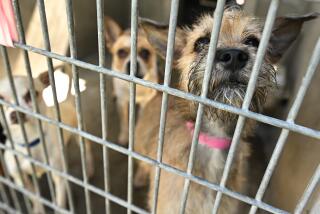Responding to Wildlife’s SOS
- Share via
When an oil tanker spilled off Huntington Beach in 1990, makeshift treatment centers popped up in lifeguard towers and an old naval supply building in San Pedro to care for thousands of birds, seals and sea lions.
“There was no facility in all of Orange County that was prepared to take in a large number of oiled birds or to treat their illnesses,” said Dr. Joel Pasco, a volunteer veterinarian.
A few years after the cleanup, the MASH-style triage centers were replaced by a spartan wildlife rehabilitation center, which took in seabirds tangled in fishing lines and land mammals such as orphaned raccoons and squirrels.
Pasco and others wanted to do more.
So for the next decade, they raised money to build a hospital that would centralize care and be twice the size of the Wetlands and Wildlife Care Center off Newland Street in Huntington Beach. They envisioned it being a vital part of the animal rescue network dotting the coast from San Diego to San Pedro.
Today, after more than a dozen years of fundraising and planning, construction will start on the hospital, which will be adjacent to the center.
The hospital’s staff will treat wild animals caught by fish hooks, injured by boats or sickened by pollution. It will be able treat animals with broken bones and those needing surgery. Those procedures that cannot be done at the center are now sent to nearby clinics.
“Once they end up there, they can go from immediate first-aid care and forced nutrition to X-ray and surgery and finally to rehabilitation pens and swimming pools,” Pasco said. “Animals don’t have to be stressed as much by moving around.”
The new building, which is expected to open in March, will have surgery rooms, recovery wards, a laboratory, a 100-seat classroom and an observation deck. With donations, officials hope to add an X-ray machine, incubators, anesthesia machines and lab equipment. “[It will] allow us to provide wildlife care that’s on par with most veterinary and human hospitals,” he said.
The center and hospital, staffed by volunteers, are collaborative efforts of the Huntington Beach Wetlands Conservancy, the Alliance for Wildlife Rehabilitation and Education and Southern California Edison. The volunteers are trained at the All Creatures Care Cottage in Costa Mesa.
The $1-million construction project is funded primarily by a $600,000 grant from the state Wildlife Conservation Board. Smaller grants from the Huntington Beach Redevelopment Agency will pay for landscaping along Pacific Coast Highway; AES Huntington Beach will pull its fences back 30 feet in some areas to accommodate expanded rehabilitation cages.
Greg Hickman, who manages the wildlife care center, remembers working the 1990 American Trader spill whose 416,000 gallons fouled the shoreline from Huntington Beach to Newport Beach. “It was just total chaos for 48 hours,” he said.
About 1,000 birds died, and the owner of the tanker that ran into its own anchor, American Trading Transportation Co., was ordered to pay $16 million in damages.
“Ten years ago, it would have taken three days to have even a minimal response to an oil spill,” Pasco said. “Now we’re up and running the minute they come in the door.”
Since the wildlife center opened in 1998, it has taken in more than 7,000 birds from more than a dozen oil spills and rehabilitated them with an 85% success rate, Pasco said.
Susanna Kraig, who has worked at the care center for five years, said it fills an important gap in the animal rescue network as one of the few places that will take birds and land mammals. “A lot of people call and tell us they’ve been on the phone all morning or that they’ve tried to get someone to take an animal for three days,” she said. “The more people know we exist, the more animals we can save.”
Kraig estimated that the center sees 2,000 animals each year, 75% of them birds. The finished hospital and care center will have the capacity to treat 10,000 animals a year.
Besides treating sick and injured animals, organizers plan to use the hospital as a teaching facility for veterinary students and other conservation groups. The public could learn about wildlife via closed-circuit television tours.
“So many animals come in as a result of human actions. It’s a fishing line, or somebody’s cat attacks it, or an animal has poisoning,” she said. “I think we’re kind of trying to make up for all the bad things we’ve done to them.”
But like any facility run by nonprofit groups, Kraig said, the new hospital will rely on donations.
Though the grants will cover building costs, there won’t be much left for even basic medical equipment.
Already, Kraig said, there aren’t enough donations for the care center’s operating costs. The monthly water bill is $1,500.
“With the hospital, it will be even worse,” she said.
Pasco said: “The bottom line here is we need to raise more money to equip the facility. It’s a way for businesses to be a tremendous help.”
More to Read
Sign up for Essential California
The most important California stories and recommendations in your inbox every morning.
You may occasionally receive promotional content from the Los Angeles Times.










